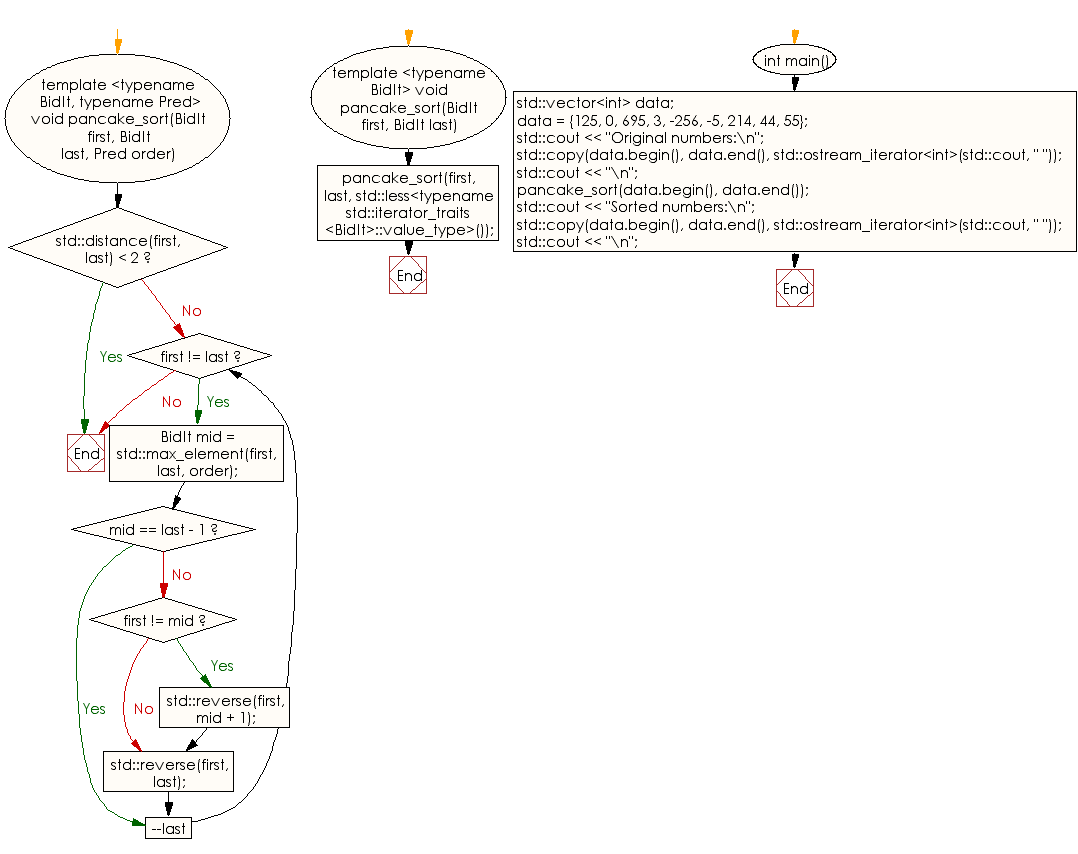C++ Pancake sort Exercise: Sort a collection of integers using the Pancake sort
11. Sort a Collection Using the Pancake Sort Algorithm
Write a C++ program to sort a collection of integers using Pancake sort.
Sample Solution:
C++ Code :
#include <algorithm>
#include <iostream>
#include <iterator>
#include <vector>
// Pancake sort template function that accepts a predicate to determine the order
template <typename BidIt, typename Pred>
void pancake_sort(BidIt first, BidIt last, Pred order) {
// If the range has less than two elements, no sorting is needed
if (std::distance(first, last) < 2)
return;
// Iterating through the range from beginning to end
for (; first != last; --last) {
// Finding the maximum element within the current unsorted range
BidIt mid = std::max_element(first, last, order);
// If the maximum element is already at the end, no flips are needed
if (mid == last - 1) {
continue;
}
// If the maximum element is not at the beginning, flip elements to move it to the front
if (first != mid) {
std::reverse(first, mid + 1);
}
// Flip elements to move the maximum element to its final sorted position
std::reverse(first, last);
}
}
// Pancake sort template function that defaults to ascending order
template <typename BidIt>
void pancake_sort(BidIt first, BidIt last) {
// Calling the pancake_sort function with default ascending order
pancake_sort(first, last, std::less<typename std::iterator_traits<BidIt>::value_type>());
}
// Main function
int main() {
// Initializing a vector with integers for sorting
std::vector<int> data = {125, 0, 695, 3, -256, -5, 214, 44, 55};
// Displaying the original numbers in the vector
std::cout << "Original numbers:\n";
std::copy(data.begin(), data.end(), std::ostream_iterator<int>(std::cout, " "));
std::cout << "\n";
// Sorting the vector using ascending pancake sort
pancake_sort(data.begin(), data.end());
// Displaying the sorted numbers after pancake sort
std::cout << "Sorted numbers:\n";
std::copy(data.begin(), data.end(), std::ostream_iterator<int>(std::cout, " "));
std::cout << "\n";
return 0;
}
Sample Output:
Original numbers: 125 0 695 3 -256 -5 214 44 55 Sorted numbers: -256 -5 0 3 44 55 125 214 695
Flowchart:

For more Practice: Solve these Related Problems:
- Write a C++ program to implement pancake sort and print each flip operation performed.
- Write a C++ program to implement pancake sort and count the total number of flips required to sort the array.
- Write a C++ program to implement pancake sort recursively and validate the final sorted output.
- Write a C++ program to simulate pancake sorting using STL algorithms to mimic the flipping process.
Go to:
PREV : Sort a Collection Using the Merge Sort Algorithm.
NEXT : Sort a Collection Using the Quick Sort Algorithm.
C++ Code Editor:
Contribute your code and comments through Disqus.
What is the difficulty level of this exercise?
